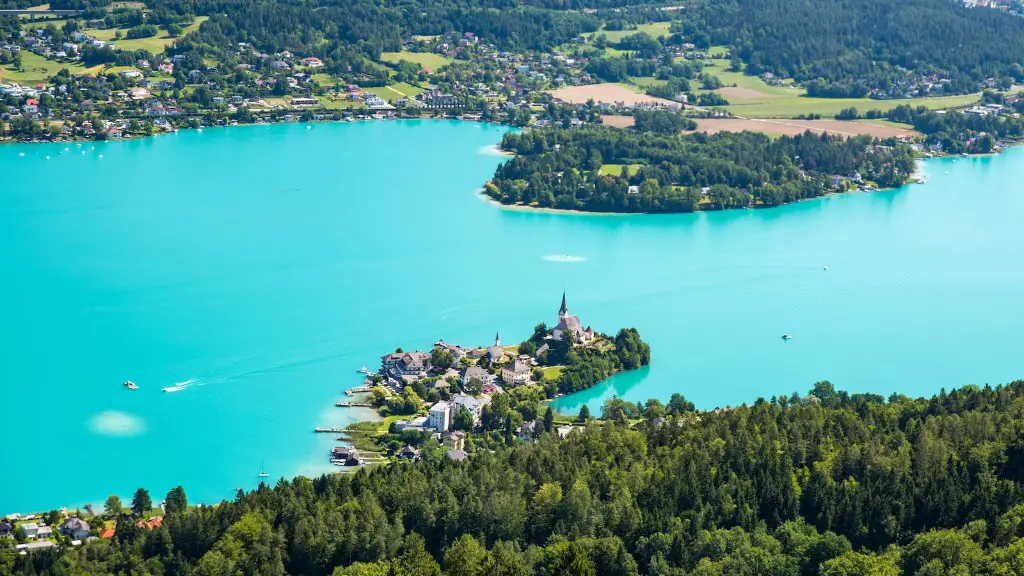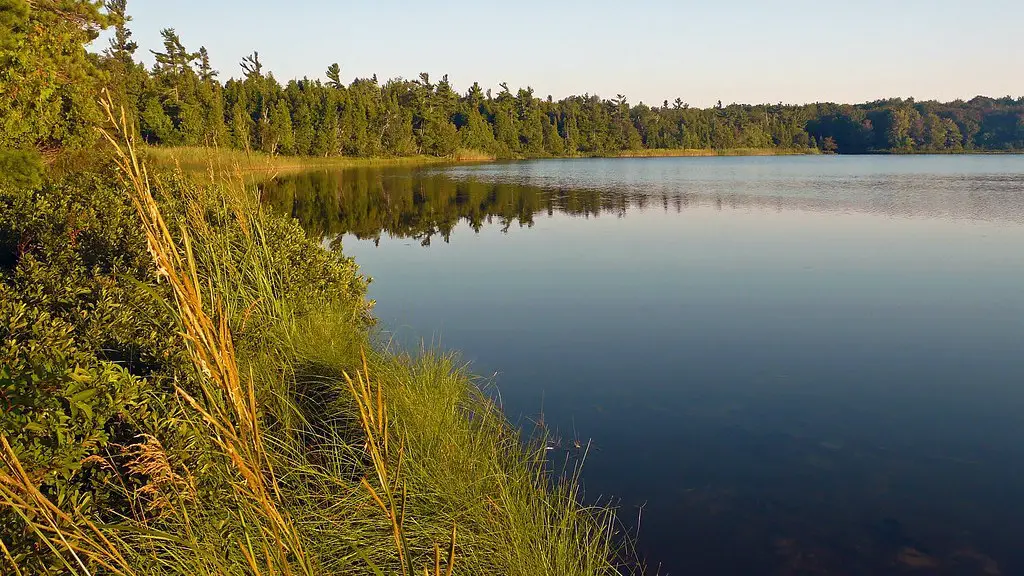When Will Lake Michigan Water Level Drop?
Lake Michigan, the fifth largest lake in the world, is one of the most important bodies of water in the United States. It provides drinking water, sustains a variety of fish and invertebrate species, and supports diverse industries such as fisheries, shipping, and tourism. The water levels of Lake Michigan are important to the health of its communities and its ecosystems.
Records show that water levels in Lake Michigan have varied significantly since the early 19th century. Over the past two decades, the water levels have been generally stable, but have had periods of both high and low levels due to changes in the climate and various man-made sources. In 2020, water levels hit their highest recorded levels since the late 19th century, and now the question is – at what point will those levels start to drop?
To answer this question, experts point out the need to understand the various factors that contribute to water levels in Lake Michigan. These include precipitation, evaporation, water supplies from connecting lakes and rivers, and water released through locks and dams. Experts also point to the increasingly unpredictable nature of rainfall and snowfall in the region and the impact of climate change on precipitation levels.
In order to assess and predict water levels, experts have turned to statistical modeling. Modeling can help to predict the impact of climate change, analyze seasonal trends in water level changes and assess the influence of human activities such as pumping groundwater, building roads that reduce runoff, and constructing dams and locks. Modeling can also help to estimate the long-term changes in water levels.
Based on current data and statistical models, experts predict that Lake Michigan water levels will likely start to decline in the next two to three years. However, there is also a chance that the level may stabilize and remain near current levels for a longer period of time. The exact timing of the downturn in water levels will depend on a variety of factors, such as the amount of rain and snowfall, the extent of human activity in the region, and the strength of El Niño and La Niña events.
It is important to note that water levels in Lake Michigan can have a significant impact on the local communities and ecosystems. Therefore, governments and communities should take steps to ensure that the impacts of any drop in water levels are managed effectively. This includes considering measures such as setting up water conservation programs, improving water infrastructure, minimizing runoff, and setting up adequate warning systems for residents and businesses near the lake.
River discharge to Lake Michigan
Water flowing through rivers and streams is a significant contributor to the lake’s water levels — in fact, it is estimated to account for up to 60% of the lake’s volume. As a result, the river discharge to Lake Michigan is one of the key factors affecting its water levels.
It is important to note that the amount of water flowing into Lake Michigan is not constant — it tends to vary with the seasons and can also be affected by man-made activities such as dam construction and the use of dredging to increase river capacity. Additionally, changes in the climate can also impact the river discharge, as extreme weather events such as floods or droughts can cause sudden shifts in water levels.
Given the importance of the river discharge to Lake Michigan’s water levels, experts recommend monitoring it closely in order to anticipate any drops. This can help to ensure that communities living near the lake can take steps to protect their livelihoods in the event of any decline in water levels.
Changes in the lake’s ecosystems
Another factor to consider when trying to predict water levels in Lake Michigan is the impact that any decline could have on the lake’s ecosystems. Lake Michigan’s waters are home to a variety of fish and invertebrate species, and any decline in water levels could reduce their numbers. Reductions in fish and invertebrate populations would in turn have an impact on the recreational and commercial fisheries which depend on the lake’s resources for their survival.
In order to mitigate the impact of any decline in water levels on local fisheries and other ecosystems, experts suggest managing the pressure placed on the lake’s resources. This includes measures such as setting up planning processes to protect wetlands and other environmentally sensitive areas near the lake, as well as establishing tighter regulations on the number and size of boats allowed to operate in the lake. Additionally, governments and communities should consider implementing conservation measures such as restrictions on water use and increased public awareness campaigns.
Impact of climate change on water levels
Another key factor to consider when predicting water levels in Lake Michigan is the role of climate change. As the climate continues to warm, the amount of rain and snowfall in the region is becoming increasingly unpredictable. In addition, the warmer temperatures can lead to more rapid evaporation of water, which can reduce the lake’s water levels.
Given the uncertain nature of climate change, it is difficult to predict exactly how Lake Michigan’s water levels will be impacted. However, experts agree that the lake’s water levels are likely to be significantly impacted by the phenomenon, and that the most effective way to manage any decline is to invest in resilience measures. These include measures such as strengthening levees, constructing green infrastructure systems, and developing drought-resistant crops.
Political responses to declining water levels
When it comes to any decline in water levels in Lake Michigan, political responses are likely to play a key role. One of the most important tasks will be to ensure that all levels of government – local, state, and federal – are working together to manage any impacts. This may include developing strategies to mitigate the impact of any loss of water, in addition to allocating resources for responding to drought-related emergencies such as food shortages, water shortages, and health crises.
In addition, it will be essential for governments to work with local communities to ensure that any drop in water levels does not have an adverse effect on their livelihoods. This could include providing financial assistance to those affected, as well as investing in measures such as installing water-saving systems, developing water-efficient public transport, and planting trees to reduce the impact of droughts.
Finally, governments must ensure that they take all necessary measures to ensure the long-term health of Lake Michigan. This could include engaging with local stakeholders to ensure that any development, mining, and tourism activities are managed in a sustainable manner, as well as implementing stricter regulations on water usage.
Environmental impacts
A decline in water levels in Lake Michigan could also have an impact on the local environment. experts suggest that this could include the destruction of wetland habitats and the extinction of endangered species due to the decrease in water levels. Additionally, lower levels of water in the lake could also lead to beach erosion and diminish the aesthetic appeal of the lake for residents and tourists.
To mitigate the environmental impacts of a decline in lake levels, experts recommend implementing measures such as installing shoreline protection structures, restoring wetlands, and reducing pollution levels. Additionally, governments and local communities should consider investing in conservation programs to protect the lake’s wildlife and other ecosystems.
Finally, experts suggest that governments and communities need to collaborate on developing new strategies for managing the lake’s resources if water levels do start to decline. This could include measures such as implementing stricter regulations on the use of water, planning for drought scenarios, and investing in technology that can reduce water losses.
Economic impacts
In addition to the environmental impacts, a drop in Lake Michigan’s water levels could also have a significant economic impact. This could include reduced tourism due to a lack of recreational activities, as well as losses in commercial fisheries and other industries that rely on the lake’s resources.
In order to mitigate the economic impacts of any decline in water levels in Lake Michigan, experts recommend investing in measures such as developing water-saving systems for businesses and communities, investing in infrastructure that can reduce water losses, and providing financial assistance to those affected by the decline. Additionally, governments and communities should consider investing in research and development of new technologies that can reduce the impacts of drought and other climate-related events.
Overall, it is clear that any decline in the water levels of Lake Michigan could have significant impacts on the local environment, economy, and communities. Therefore, it is essential for governments and communities to be prepared for any drop in water levels, and to take all necessary measures to ensure that the impacts are managed effectively.





